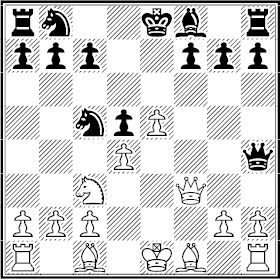
In the vast majority of cases, you can’t calculate far.
You have to trust your instinct.
Rudolf Spielmann White
Alexander Flamberg Black
Mannheim 1914
Vienna Game C29
1 e4 e5 2 ♘c3 ♘f6 3 f4 d5 4 fxe5 ♘xe4 5 ♘f3 ♗g4 6 ♕e2
Besides 7 ♘xe4 dxe4 8 ♕xe4, White threatens 7 ♕b5+.
6...♘c5? 7 d4! ♗xf3 8 ♕xf3 ♕h4+

9 g3!
There was no assurance this was better than the favorable 9 ♕f2 ♕xf2+ 10 ♔xf2 endgame.
9...♕xd4 10 ♗e3!
And 10 ♕xd5 ♕xd5 11 ♘xd5 was another superior ending. White had to trust his instinct that a two-pawn sacrifice was better.
10...♕xe5 11 0-0-0 c6
Black’s king could try to flee with 11...♘bd7 and 12...0-0-0. But 12 ♗h3! is good.
For example, 12...0-0-0 13 ♖xd5 ♕e8 14 ♗xc5. Or 12...♗e7 13 ♗f4 ♕f6 14 ♘xd5.
12 ♘xd5! cxd5 13 ♖xd5
A pretty finish is 13...♕f6 14 ♗g5! ♕xf3 15 ♖d8 mate.
Question 191: What about 13...♕e4 ?
13...♕e6 14 ♗c4!
Now 14...♘cd7 15 ♖e1 threatens 16 ♗d2, winning the queen.
Question 192: Why not 15...♗e7 ?
Also lost is 14…♕c6 15 ♖e1!, threatening ♗g5+ or ♗xc5+.
14...♕e4 15 ♗xc5! resigns.
It’s 15...♕xf3 16 ♖e1+ ♗e7 17 ♖xe7+ ♔f8 18 ♖d8 mate.
Hakon Briseid White
Joar Pettersen Black
Oslo 2006
1 e4 e5 2 ♘c3 ♘f6 3 f4 d5 4 fxe5 ♘xe4 5 ♘f3 ♗g4 6 ♕e2 ♘xc3 7 dxc3 ♕d7 8 ♗f4 ♘c6 9 0-0-0 0-0-0 10 ♕e3! ♗e7 11 ♗b5 a6 12 ♗a4 ♔b8 13 ♘d4 b5! (13...♗xd1 14 e6! fxe6? 15 ♘xc6+ bxc6 16 ♕b6+ wins) 14 e6 fxe6 15 ♘xb5 axb5? 16 ♕b6+ ♔a8 17 ♕xb5 ♘a7 18 ♕xd7 ♖xd7 19 ♗xd7 ♖d8 20 ♖xd5! e5 21 ♗xg4 ♖xd5 22 ♗f3 resigns.